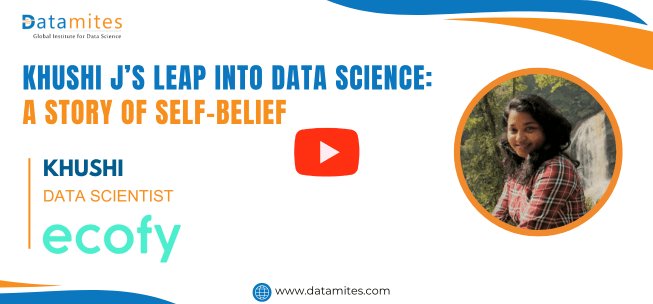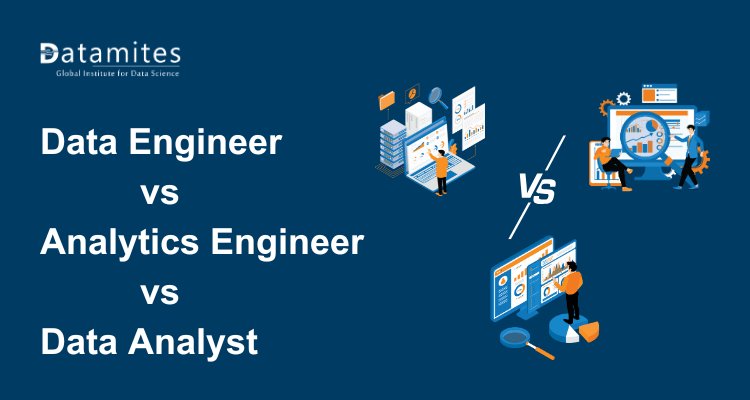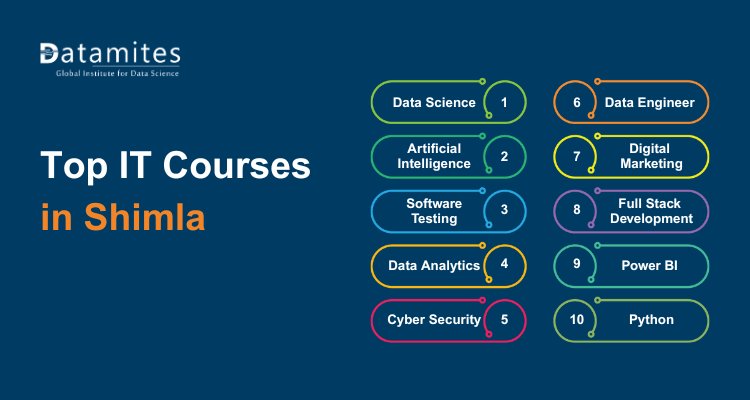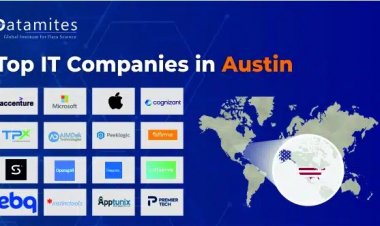Khushi J’s Leap Into Data Science: A Story of Self-Belief
Khushi J's journey into data science highlights the power of self-belief and determination. Through perseverance and continuous learning, she successfully transitioned into a thriving tech career.
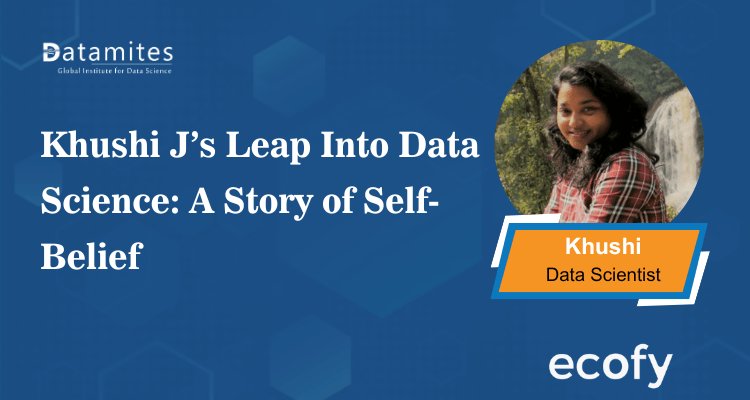
In a recent Alumna Talk hosted by DataMites, we had the privilege of interacting with Khushi J, a seasoned data scientist with diverse industry experience. Starting her journey as a developer, Khushi transitioned into the field of data science when it was still in its infancy. Her story is not only inspiring but also filled with practical advice for freshers, aspiring data scientists, and working professionals seeking a career switch.
What sets Khushi apart is her instinctive foresight and her hands-on approach. She began her career in web development and eventually found her calling in data science through her exploration of chatbots and natural language processing (NLP). In this blog, we bring you the highlights of the session in a Q&A format, where Khushi candidly shares her journey, technical insights, challenges, and valuable advice.
Khushi’s Data Science Journey: Navigating Success with DataMites
Discover how Khushi transformed her passion for data into a successful career with the expert guidance of DataMites.
1. How did your journey in data science begin?
My interest in technology was present from the beginning. After completing my MCA in 2013, I started my career as a developer. Around 2014–15, I came across chatbots, which piqued my interest in artificial intelligence. I started exploring NLP, machine learning, and eventually stumbled upon data science. That’s when I found DataMites and began formal training.
2. What role did DataMites play in your transition?
DataMites Institute provided the structured foundation I needed. Their curriculum helped me understand core concepts, and the projects we worked on gave real-time exposure. But transitioning fully into a data scientist role required going beyond coursework—taking initiative at work, building POCs, and constantly experimenting with new ideas.
3. Which area of data science fascinated you the most initially?
NLP fascinated me from the beginning. Although it wasn’t mainstream at the time—no Alexa or ChatGPT—I had a gut feeling it would become huge. My first real project involved building a basic chatbot. Even then, we were using foundational methods like text preprocessing, stemming, and simple classification models.
4. Are you still working in NLP today?
Yes and no. While I started with NLP, my current role in a fintech NBFC involves classical machine learning techniques like XGBoost and random forests. However, NLP still finds its way into our projects, especially in analyzing customer communication and document classification. And with LLMs booming, NLP is evolving rapidly.
5. What does your current job as a data scientist look like?
Surprisingly, 80% of my time goes into understanding, cleaning, and preparing data. Only 20% is actual model building. Unlike platforms like Kaggle where datasets are clean and structured, real-world data is messy. Apart from ML, I often work with data engineering, business analytics, and stakeholder communication.
6. Can you describe the tech stack or tools you use regularly?
I use Python primarily, along with libraries like Pandas, NumPy, Scikit-learn, and sometimes TensorFlow or PyTorch. For data visualization, Power BI and Tableau are common. We use cloud services like AWS for data storage, compute resources, and model deployment.
7. How important is data engineering knowledge in your role?
Very important. As a data scientist, you can’t rely solely on your modeling skills. You must understand data pipelines, ETL processes, databases (SQL/NoSQL), and APIs. Sometimes you also deal with real-time data, where understanding streaming architectures becomes essential.
8. What projects stood out in your early learning phase?
One of my earliest projects was a spam classifier—spam vs ham. While basic, it taught me the end-to-end ML pipeline. But to stand out, I started developing domain-specific projects, like chatbots and predictive models in fintech. Industry relevance is key.
9. How can freshers choose the right projects to showcase on their resume?
Always align your projects with industry use cases. Avoid generic datasets. Instead, simulate projects with measurable business impact—like churn prediction for telecom, fraud detection in fintech, or recommendation systems for e-commerce.
10. What advice do you have for freshers struggling to land their first job?
Be patient and persistent. There’s often a big gap between what you learn and what you implement in real life. Build a strong GitHub profile, contribute to open-source, network with professionals, and don’t shy away from unpaid internships or freelance gigs to build your portfolio.
11. What skills do recruiters look for in entry-level data scientists?
Recruiters expect more than theoretical knowledge. They look for:
- Real-world project experience
- Problem-solving ability
- Communication and storytelling skills
- Business understanding
- Exposure to version control (Git), cloud platforms, and APIs
12. How do you keep yourself updated in such a fast-changing domain?
I follow tech blogs, attend webinars, read research papers, and stay active on LinkedIn. I also experiment regularly with new tools and techniques—especially in LLMs and generative AI. Staying relevant is a continuous process.
13. How do you balance specialization vs generalization?
You don’t need to be an expert in everything. But you must have depth in your area of interest and breadth to understand adjacent technologies. For example, if NLP is your focus, understand transformers well but also know about classical ML, data pipelines, and deployment basics.
14. What’s the biggest myth about being a data scientist?
That it’s all about building cool models. In reality, it’s a multidisciplinary role involving a lot of communication, data wrangling, and collaboration. Models are important, but your business impact and ability to tell a story with data matter even more.
15. What are your future aspirations in this field?
I aim to work more deeply in LLMs and responsible AI. I want to contribute to making AI more explainable, ethical, and business-aligned. I'm also exploring leadership roles where I can guide teams and strategize data science initiatives at scale.
Refer these articles:
- Aditya Chowdari’s Inspiring Path to Success in Data Science
- From UPSC Aspirant to Data Scientist: Kiran’s Journey to Success
- Inspiring Data Science Journey of Yash Sahindrakar
How Khushi Achieved Success in Data Science: Key Takeaways
Discover the essential steps and insights that helped Khushi excel in the world of data science.
- Curiosity is the Starting Point: Khushi's career shift began with a natural curiosity sparked by chatbots, leading her to explore NLP and machine learning.
- NLP is the Gateway Drug to Data Science: For many, NLP projects like chatbots or sentiment analysis are great starting points, even more so now with LLMs taking over.
- Real-World Data ≠ Kaggle Data: In the real world, 80% of your time goes into cleaning, understanding, and engineering the data.
- Stay Domain-Relevant: Tailor your projects based on the domain you want to work in. Each industry—fintech, healthcare, e-commerce—has distinct challenges.
- Presentation and Business Acumen Matter: Building a great model is not enough. You must explain your insights to stakeholders in a way that drives business value.
- Keep Learning: Whether it’s cloud platforms, emerging AI tools, or ethics in AI—there’s always something new to learn in this space.
- Build for Impact: Choose projects that solve real problems. A spam classifier may help you understand the basics, but a fraud detection system or loan eligibility predictor will get recruiters’ attention.
- Communication is Crucial: A data scientist is part technologist, part storyteller, and part business analyst. Communication is as important as coding.
Khushi J’s story is a shining example of how passion, persistence, and purposeful learning can transform a career. Her journey from a web developer to a data scientist at the forefront of AI innovation reflects the dynamic evolution of the tech landscape—and what it takes to stay ahead.
Refer these articles:
To all aspiring data scientists, take this session as both motivation and guidance. The path isn’t easy, but with curiosity, discipline, and continuous learning, it’s absolutely achievable.
If you’re thinking about switching to a career in data science, Khushi’s journey shows that now is the ideal time to take the leap. The global data science platform market was valued at USD 96.25 billion in 2023 and is expected to grow at a 26.0% CAGR from 2024 to 2030, according to Grand View Research, making it a field full of opportunities. Khushi recognized this growing demand early on and decided to upskill through a program focused on hands-on learning, real-time internships, and strong placement support—crucial factors for success in today’s competitive landscape. Enrolling in a data science course in Bangalore, Hyderabad, Chennai, Pune, Mumbai, or Delhi can be the first step toward building a successful tech career.
Khushi chose DataMites Institute, a leading training provider in Data Science, AI, Machine Learning, Python Development, and Data Analytics. Accredited by IABAC and NASSCOM FutureSkills, DataMites provided her with expert-led training, real-world projects, and comprehensive placement assistance that helped her transition smoothly into the data science field.
With flexible learning options—including offline Data Science training in Bangalore, Hyderabad, Chennai, Pune, Ahmedabad, Coimbatore, and Mumbai—Khushi was able to select the format that best fit her schedule and learning preferences. DataMites’ industry-relevant curriculum empowered her, like many others, to successfully pivot into a data-driven career despite her background.
